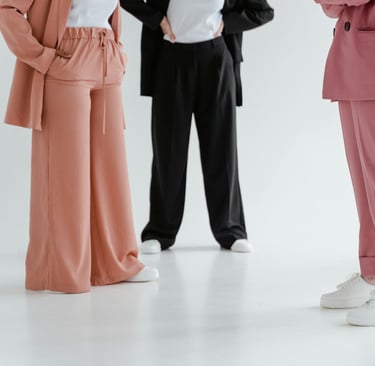HOW CLOTHING BRAND WORKS?
. If you've ever wondered what goes on behind the scenes of a successful clothing business, let's take a deep dive into how the industry really works.
Brigita Founder
3/8/20253 min read


How the Clothing Business Works: A Deep Dive into the Industry
Behind every great fashion brand is a well-oiled machine of creativity, logistics, and business strategy. While clothing might seem like a creative endeavor, the reality is that the fashion industry is an intricate network of production, supply chains, marketing, and sales. If you've ever wondered what goes on behind the scenes of a successful clothing business, let's take a deep dive into how the industry really works.
From Concept to Creation: The Design Process
Every clothing brand begins with an idea. Whether it’s inspired by cultural movements, personal experiences, or emerging fashion trends, the design process is where a brand’s identity takes shape.
Successful brands don’t just design what they like; they design what people will buy. Fashion businesses invest heavily in trend forecasting, analyzing consumer behavior, and studying the market to predict what styles will sell in the upcoming seasons. Once trends are identified, designers create sketches that evolve into technical drawings (tech packs). These contain details on fabrics, stitching, and construction methods. Prototypes or samples are then created to test the design’s viability.
Note: Many emerging brands fail because they skip trend research, creating designs that don’t align with consumer demand.
The Business Side of Fashion: Operations & Financial Planning
Running a clothing business goes far beyond designing—it requires careful financial planning, operational efficiency, and strong business acumen.
Every brand must decide on a business model:
- Direct-to-Consumer (DTC): Selling directly through an online store, maintaining full brand control and higher profit margins.
- Wholesale: Selling to retailers who distribute the products, offering wider reach but lower margins.
- Private Labeling: Manufacturing products for other brands under their name.
- Print-on-Demand: Producing items only when an order is placed, reducing waste and upfront costs.
Understanding cost structures is essential. Brands need to consider:
- Production Costs: Materials, labor, and logistics.
- Overhead Costs: Marketing, website maintenance, employee salaries.
- Retail Markups: Typically 2.5x to 4x production costs for sustainable profit margins.
Note: Many brands fail because they price too low to compete, forgetting to account for long-term sustainability.
Supply Chain & Inventory Management
Behind every successful fashion brand is a well-managed supply chain. A streamlined process reduces costs, prevents overstock, and ensures timely deliveries.
Choosing reliable suppliers is crucial:
- Establishing strong partnerships leads to better pricing and consistent quality.
- Brands must negotiate Minimum Order Quantities (MOQs) to balance inventory needs and budget constraints.
Poor inventory management can destroy a business. Brands need to:
- Use inventory forecasting tools to predict demand.
- Avoid overproduction, which ties up cash flow.
- Implement pre-orders or limited drops to test demand before mass production.
Note: Smart inventory management is the difference between a profitable brand and a bankrupt one.
Marketing, Branding & Sales Strategies
Fashion is more than just products - it’s about branding, storytelling, and connecting with the right audience.
Successful fashion businesses focus on multi-channel marketing:
- Social Media: Instagram, TikTok, and Pinterest drive brand awareness.
- Influencer Collaborations: Partnering with micro-influencers for authentic engagement.
- Email Marketing & SMS Campaigns: Retaining customers and driving repeat sales.
Brands need a solid sales strategy:
- E-Commerce Optimization: User-friendly websites with high-converting product pages.
- Retail Partnerships: Building relationships with boutiques and department stores.
- Pop-Ups & Events: Strengthening brand presence with offline activations.
Note: The best brands don’t just sell clothes - they sell lifestyle, exclusivity, and identity.
Scaling & Long-Term Success
Growing a clothing brand requires long-term financial strategy:
- Keeping cash flow positive to reinvest in growth.
- Securing funding through investors, grants, or crowdfunding.
- Expanding smartly - whether through new product lines or international markets.
Modern consumers care about sustainability. Brands must:
- Source eco-friendly fabrics.
- Implement ethical labor practices.
- Reduce waste through smart inventory control.
Note: Consumers are willing to pay more for sustainable and ethical brands, making it a strong business advantage.
Building a Fashion Business That Lasts
Starting and growing a clothing business isn’t just about creativity - it’s about strategy, resilience, and smart decision-making. If you’re ready to build a fashion brand that stands the test of time, focus on strong planning, market research, and building meaningful connections with your audience.
x Brigita
Founder
